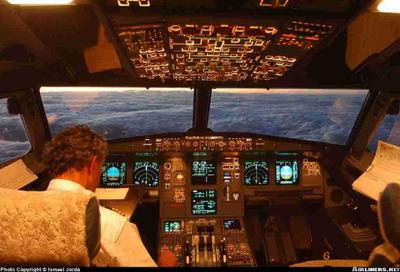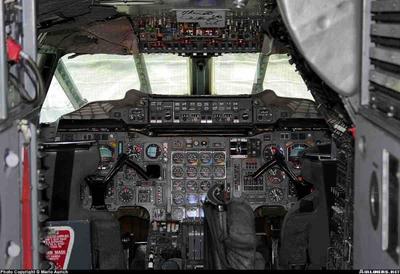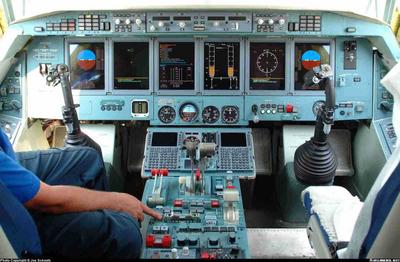
(Here's a look at the cockpit of my beloved DC-8, the quintessential old airplane.)
Ernest K. Gann, in "Fate is the Hunter," wrote about the cockpit as a kind of inner sanctum, and wrote eloquently about the hush and trance-like concentration that are part and parcel of the flight environment. (If you are interested in flying things, it's a fantastic read about the earliest days of airline flying.) I've had a fascination with airplane cockpits since long before I learned how to fly. I remember having had a 747 cockpit poster on my bedroom wall thru all of my teen years (though I had forgotten that until just now). Today, I have a lovely--well, lovely in an oily, machinery geek sort of way--collection of a couple hundred cockpit photos on my computer, and my desktop is often set to this folder so that I'm treated to a rotation of pilot workplaces during the day. Let's look at some of them, shall we?

(The Dornier 328, my last airplane.)
I think it's more than just a fascination with machinery, though most little boys (and pilots) need nothing else to hold their interest. I think there's the idea that this huge machine must be controlled, and so every system and control function must be routed in a systematic way up to this tiny room at the front, like all the functions of the body's nervous system terminating at, or originating from, the brain. All these myriad systems, flight instruments and navigation, operational things like electrics and hydraulics and fuel systems (each quite complicated in itself), all interface in this small area. And because we use this cockpit not simply as a convenient place to read the newspaper, but to control the airplane, it becomes a kind of bionic attachment to us, a cybernetic extension of our bodies. I pull back on the yoke and rotate it to the right, and the whole huge machine pitches and tilts to my command, like the movement of my own limbs but hugely exaggerated.

(Airbus A-320, quintessential modern airplane.)
And further: the airplane is a product of human design, envisioned and built for human needs; our cockpit is not what a cow or a manatee would come up with (I was going to say sparrow, but a sparrow don't need no stinking cockpit). And so, after some basic decisions are made, we get to the study of ergonomics. True, there's physics underneath, but out of an almost infinite range of forms the endeavor might have taken (and early airplane cockpits were all over the place!), we settled on what we now have and we work within a fairly narrow range, evolving and refining a known and trusted concept. To look at a hundred different airplane cockpits is to see the products of 100 different herculean industrial design processes trying to solve the same problems, but in ways that extend far beyond simple stylistic decisions.

(The Concorde, the world's fastest passenger aircraft--sadly, now retired.)
What is called ergonomics in automotive design, where it deals with comfort and convenience, becomes in the world of aviation the study of human factors. Here, it goes beyond whether it's a pain in the ass to have to reach too far for the radio knob or whether your Big Gulp irritatingly blocks your view of the climate control system display; the layout of switches and controls--more than this, the very design of a system and its user / machine interface--becomes the product of intensive study and years of research and data collection.

(A Russian Beriev seaplane, one of very few large airplanes with a stick--instead of a yoke.)
A prime example (I blabbed about this before here @ "Flying Stuff"): when airplanes for years had had three crewmembers, the business of engineering the flight engineer out of the cockpit in the late '60s was no easy task: what about the jobs he used to do? How do we push those tasks off onto pilots, whom we have long believed had their hands full just flying the airplane? How do we design the systems NOT TO NEED routine human intervention?
I can hear my wife now. "OH... MY... GOD!! OMYGODOMYGODOMYGOD!! WHAT IS WRONG WITH YOU?!" Hey, when you spend a thousand hours of your year locked in a broom closet with a couple other guys, this shit comes to matter!
This plea will fall on deaf ears. OK, I better stop.
13 comments:
Is the -8 CAT II capable?
Yessir. Our 727s accomplish this with a HUD, but not with the 8. We have no autothrottles, and there is no autoland. A/P must be off @ 70 feet.
Your 727s have HUDs? Wow...thats not too bad. Kills the all important instrument cross check for sure...but its a great feature to have. Flying a large aircraft with a stick is not too difficult...was an easy transition from the yoke. Now the whole airbus stick-on-the-side thing...that must take some getting used to.
My only stick time is the 6.5 hours it took me to get a tailwheel signoff a decade ago. But it was enough to convince me that this is unquestionably the control layout an airplane should have. The yoke seems bogus after that! I found it odd for about 25 seconds and never thought about it again until back in a Cessna and ruing that the stick was gone.
This Beriev is the only big airplane I know of with a stick (fighters, of course, excepted).
I feel like a guy whose just wandered into a really technical discussion of airplane specs.
Why is that?
Of course I meant "who's" as in a contraction of "who has," and not "whose" as in the possessive form of "who."
That was funny, though, huh?
Actually, thanks to modern medicine, airplanes no longer require specs.
Also, can one contract "who has?" Or is physical contact required?
ba-DUM CRASH!
C-17s have sticks as do several Airbus models...including the A380 (i believe...am certian of the -17 having one, however)
Yeah, I'm not communicating my thoughts very carefully.
All modern Airbuses (minus the A-300 & 310) have a fly-by-wire sidestick controller. As the car steering wheel traces its origin to a boat's tiller, so this sidestick traces its lineage to the old control stick found in every airplane until, I suppose, the '40s or so. (I have a book on the history of the aircraft cockpit, and I should look that up when I get home: where did the yoke / wheel come from and when?) So the basic concept is not any kind of revolution. But the devil is in the details.
Interestingly, the Boeing 777 is fly-by-wire and they made a conscious decision to retain a "normal" control column and yoke, saying that the Airbus-style electronic sidestick was "disrespectful" to pilots! I'm sure it's a brand differentiation thing primarily (since Airbus got there first), but their stated rationale was that since the Airbus stick doesn't move when the other pilot is flying or when on autopilot, the pilot doesn't know intimately what the airplane is doing (their throttles also don't physically respond to autothrottle inputs).
Viewed from this angle, the disrespect thing is not so absurd a claim--indeed, it's the taking the pilot out of the loop that is the prime criticism levelled at Airbus's cockpit design philosophy. For the first time in the history of commercial aviation, the airplane is being flown entirely by computer, with the pilot reduced to the role of computer inputter via simulations of traditional pilot controls. This is pretty seamless until oddities are encountered--the cross-control of a crosswind landing, for example--and then "the computer knows best" and you're not allowed to un-coordinate the airplane. My A-320-flying friends hate this, and I can see why.
I think Boeing got it right, not in control format but in implementation. The 777 (and now the 787, I imagine) gains the advantages of fly-by-wire, but the control columns & yokes (and throttles) mimic what airline pilots have lived with for 60 years.
I didn't know that about the C-17. I'll have to find a picture.
http://www.pbase.com/ralf/image/46066525
Here is a picture I found of the -17 flightdeck. I'm neither of those guys in the seat!
The -17 is a fly by wire that has a mechanical backup. Another interesting thing is the way it lands: backside (up/down controls speed, throttles control altitude) If you ever see one on approach it appears as if it is in a constant flare. When flaps are rolled to 3/4 and the jet is established on approach the PF hits a switch on the stick that "freezes" the nose to the current attitude (usually 5 degrees nose high for non-assault landings). The stick is then used only for left/right corrections. Throttle is added at 50 feet (amount depending on gross wt) to slow the decent. The power push replaces the need to flare.
Full flap (40 degrees) are done for SAAF (Short Austere Airfields) landings. The -17 can fly down a 5 degree glidepath (8 degrees AoA) and land with up to 660vvi, a great way to plant the jet and dissipate energy. The flaps also allow a jet weighing up to 400K to have an approach speed of 120-130kts.
Absolutely fascinating. It reminds me of helicopter flying, where you'd think that flying is flying but in fact you have to, as a fixed wing driver, pretty much throw out all the instincts it took you a couple thousand flight hours to accumulate. I mean, here your hands and feet do something similar to what an airplane pilot's do, but with enough differences that you have to come up with a whole new skillset; to see precious airspeed drop to nothing during a hover would be to wander deep into a realm where any normal pilot is having "death" whispered loudly in their ear.
How long did it take you to get the handle on flying an approach this way? And do you fly other things where you're back in the regular pitch / power relations? I guess life is more normal at other times even in the 17 when you're not on approach. So you kinda switch back and forth? Or does it all just happen naturally as you bracket what you're doing with the controls?
Great cockpit photo (I've added it to my collection!).
"Full flap (40 degrees) are done for SAAF (Short Austere Airfields) landings. The -17 can fly down a 5 degree glidepath (8 degrees AoA) and land with up to 660vvi, a great way to plant the jet and dissipate energy. The flaps also allow a jet weighing up to 400K to have an
approach speed of 120-130kts."
After reading this, both my eyeballs ruptured, caught fire and ran from the room screaming.
I don't know what was more upsetting to me: that my eyeballs ruptured, caught fire and ran from the room screaming, or that I just now, after 35 years of life, discovered that not only do my eyeballs have legs, but also they possess the ability to scream.
The things you learn on blogs.
I have not flown a "frontside" landing aircraft since getting into the 17....but had flown 3 previously. In our EP sims with abnormal configurations (no slats...1/2 flaps or less) we do practice landing the 17 frontside...but we do not do any simulated EPs in the acual aircraft...not even pulling and engine back. Believe it or not its pretty easy to make the change to "backside" landings. The thing you need to watch our for...especially for those with thousands of hrs in other aircraft, is the ol' human facors problem...regression. If one gets really in the thick of things and gets back to thinking they are landing something else, especially at that key 50 foot power push, that can be a major problem. Pulling the power at 50 feet kills the "powered lift" concept that those McD-Douglas engineers designed into the jet. It also makes the aicraft drop like a rock, a good thing if you are trying to get down at altitude...but not if you are at 50 feet...well into the land of the unrecoverable sink rate.
I keep hearing that there are "some" companies that want to buy the commerical version of the -17...but am not sure who they would be or why they'd need to move 170,000 pounds of outside cargo and land on a 3500 foot runway.
Post a Comment